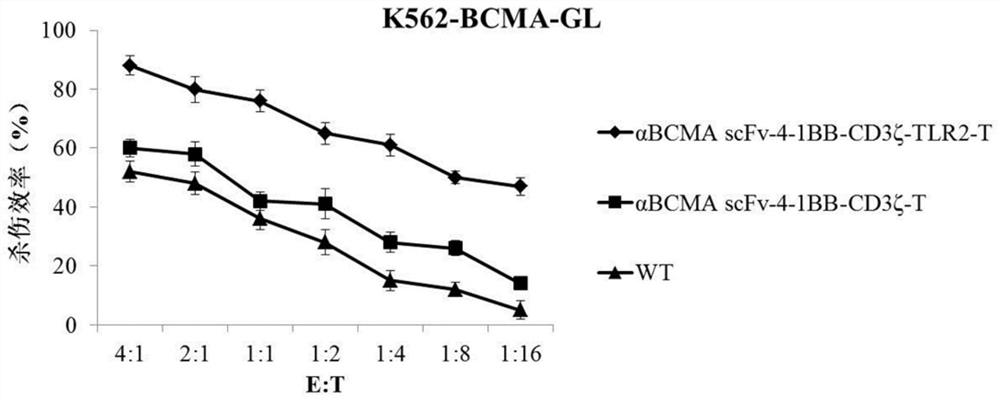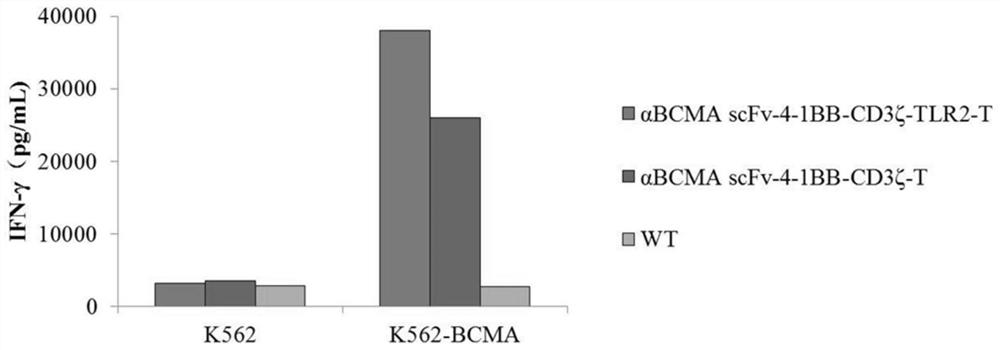Chimeric antigen receptor T cell targeting BCMA and application of chimeric antigen receptor T cell
A technology of chimeric antigen receptors and cells, applied in the field of biomedicine, can solve problems such as cytokine storms, achieve the effects of low incidence of side effects, high killing efficiency, and good clinical application prospects
- Summary
- Abstract
- Description
- Claims
- Application Information
AI Technical Summary
Problems solved by technology
Method used
Image
Examples
Embodiment 1
[0037] The preparation of embodiment 1CAR carrier
[0038] The schematic diagram of the structure of the chimeric antigen receptor targeting BCMA constructed in this example is as follows figure 1 Shown, the amino acid sequence is shown in SEQ ID NO: 1, and the coding gene is shown in SEQ ID NO: 2;
[0039] Add restriction endonuclease Pme1 digestion site and its protective base and restriction endonuclease Spe1 restriction endonuclease Spe1 restriction site and its protection base to the C-terminal and N-terminal of the above coding gene respectively;
[0040] The coding gene was double-digested with restriction endonucleases Pme1 and Spe1, and the digested product containing cohesive ends was recovered by agar gel electrophoresis, and then ligated into the linearized pWPXLd-eGFP plasmid (containing sticky ends), the ligation reaction was carried out with the participation of T4 DNA polymerase (Invitrogent) to obtain a lentiviral vector containing the gene encoding αBCMAscFv...
Embodiment 2
[0042] Example 2 Recombinant lentiviral packaging
[0043] In this example, 293T cells were used to prepare recombinant lentiviruses, and when the 293T cells spread to 80-90% of the bottom of a 100mm culture dish, the lentiviruses were packaged:
[0044] 2 hours before virus packaging, replace the medium with DMEM containing 1% fetal bovine serum, and add 6mL / 100mm culture dish;
[0045] Prepare the plasmid mixture shown in Table 1, the pWPXLd-expression plasmid is a lentiviral vector expressing the CAR molecule, and the pWPXLd-eGFP plasmid is an empty vector that does not contain the gene encoding the CAR molecule;
[0046] Table 1
[0047]
[0048] Add 36 μg PEI to another 500 μL opti-MEM medium, mix well, and let stand at room temperature for 5 minutes;
[0049] Mix the plasmid mixture shown in Table 1 with PEI, mix well by pipetting, and let stand at room temperature for 25-30 minutes;
[0050] Add the above mixture dropwise to the 293T cells cultured in a 100mm cult...
Embodiment 3
[0054] Example 3 T cell activation and lentiviral transfection
[0055] Peripheral blood mononuclear cells (PBMC) were separated from whole blood using Ficoll density gradient centrifugation kit (GE Company), and after red blood cells were removed, T cells were sorted out using MACS Pan-T magnetic beads;
[0056] The sorted T cells were diluted with medium (AIM-V medium + 5% FBS + penicillin 100 U / mL + streptomycin 0.1 mg / mL) to a cell concentration of 2.5×10 6 pcs / mL for use;
[0057] CD2 / CD3 / CD28 T cell activation expansion kit (Miltenyi Company) was used to activate T cells, that is, the coated magnetic beads were mixed with T cells at a ratio of 1:2, and the final density of T cells was 5×10 6 piece / mL / cm 2 , after mixing, place at 37°C, 5% CO 2 The incubator was stimulated for 48 hours;
[0058] After T cells were activated for 48 hours, the beads were demagnetic, centrifuged at 300 g for 5 min, and the supernatant was removed. T cells were resuspended in fresh medium...
PUM
 Login to View More
Login to View More Abstract
Description
Claims
Application Information
 Login to View More
Login to View More - Generate Ideas
- Intellectual Property
- Life Sciences
- Materials
- Tech Scout
- Unparalleled Data Quality
- Higher Quality Content
- 60% Fewer Hallucinations
Browse by: Latest US Patents, China's latest patents, Technical Efficacy Thesaurus, Application Domain, Technology Topic, Popular Technical Reports.
© 2025 PatSnap. All rights reserved.Legal|Privacy policy|Modern Slavery Act Transparency Statement|Sitemap|About US| Contact US: help@patsnap.com



